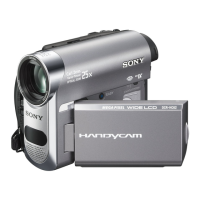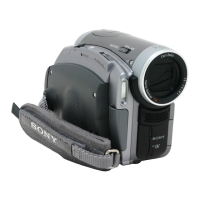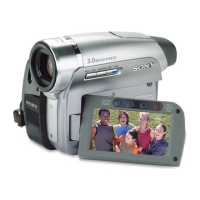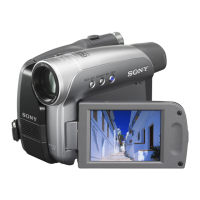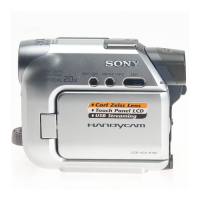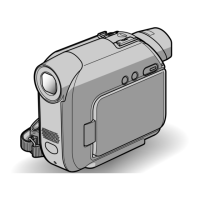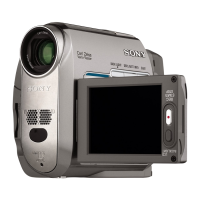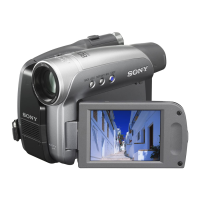Do you have a question about the Sony Handycam DCR-HC85 and is the answer not in the manual?
Identifies the specific camcorder model.
Safety precautions to prevent fire, shock, and damage to the unit.
Details for US/Canada customers regarding battery recycling and FCC compliance.
Declarations of conformity and FCC compliance statements for the camcorder.
Section to record model and serial numbers for reference.
Information on cassette memory and compatible memory sticks.
Guidance on protecting the LCD, viewfinder, and lens from damage or malfunction.
How to record still photographs using the camcorder.
Techniques for adjusting exposure for optimal image brightness.
Methods for adjusting focus on subjects for clarity.
Using specialized functions for recording in dark or low-light conditions.
Navigating and utilizing the camcorder's menu interface for settings.
Procedures for copying and editing video content between devices.
Step-by-step instructions to begin recording video movies.
Step-by-step instructions to begin recording still photographs.
Explanation of the simplified mode for easy recording and playback.
List of all accessories included with the camcorder for initial setup.
Instructions on how to charge the camcorder's battery pack.
Procedures for removing the battery and checking its status.
Guide on powering on the camcorder and selecting operational modes.
Information on using the AC adaptor for continuous power.
Instructions for optimizing the view through the LCD and viewfinder.
Guide for setting the camcorder's internal clock and date.
Instructions for inserting a mini DV cassette tape.
Procedures for inserting and removing Memory Stick Duo cards.
Guide for selecting the camcorder's display language.
Steps to record video movies onto tape or Memory Stick.
Explanation of on-screen indicators during recording.
Tips for maximizing recording duration on tape and Memory Stick.
Operating zoom and mirror mode for varied shooting perspectives.
Using self-timer and progressive mode for specific recording needs.
Guide to recording still photographs onto a Memory Stick Duo.
Techniques for burst shooting and understanding recording indicators.
Options for choosing image quality and resolution for still photos.
Configuring flash modes, including red-eye reduction.
Using the self-timer to capture still images with a delay.
Using the simplified mode for easy movie recording.
Steps for activating and using Easy Handycam for recording movies and stills.
Advanced settings and tips for the Easy Handycam operation.
Techniques for optimizing exposure, including backlit subjects.
Focusing exposure control on a specific subject.
Detailed steps for manually controlling exposure settings.
Using NightShot Plus and Color Slow Shutter for dark environments.
Information on automatic and spot focus adjustment.
Focusing on subjects not in the center of the screen.
Detailed steps for manually adjusting focus using the focus ring.
Using expanded focus to aid manual focusing.
Overview of visual effects like Fader.
How to apply fade-in and fade-out effects to video.
Superimposing images and applying digital effects to recordings.
Using slow shutter for low light and old movie effect for atmosphere.
Superimposing still images onto tape recordings using Memory Mix.
Detailed steps for the Memory Mix function to overlay images.
Using END SEARCH and EDIT SEARCH for finding recording points.
Playing back the most recently recorded scenes for review.
Steps to play back video recordings stored on a cassette tape.
Understanding playback indicators and using scan controls.
How to play back in different modes like slow or frame-by-frame.
Adding digital effects to recorded footage during playback.
Steps to view recordings stored on a Memory Stick Duo.
Explanation of icons shown during Memory Stick playback.
Dividing movies into scenes for easier playback navigation.
Using the simplified mode for easy playback of recordings.
Advanced settings and tips for Easy Handycam playback.
Magnifying playback footage from tape or Memory Stick.
Showing screen indicators, time codes, and data during playback.
Connecting the camcorder to a television for playback.
Methods for finding specific scenes on tape using memory or titles.
Locating scenes by searching for recorded titles.
Locating scenes based on the date they were recorded.
General instructions on navigating and selecting menu options.
Managing shortcuts and customizing the Personal Menu.
Accessing and adjusting camera-specific settings like Program AE.
Adjusting white balance for accurate color representation in various lighting.
Adjusting sharpness, auto shutter, focus, and expanded focus.
Configuring flash modes, levels, and red-eye reduction.
Information on the Super NightShot Plus feature.
Using NightShot Light, Color Slow Shutter, and Digital Zoom.
Recording in 16:9 widescreen format for compatible TVs.
Compensating for camera shake using SteadyShot.
Information on the progressive recording mode.
Managing Memory Stick settings like burst shooting and quality.
Recording multiple still images consecutively.
Choosing image quality and resolution for still photos.
Adjusting image size for movie recordings.
Displaying the remaining capacity of the Memory Stick.
Deleting all data or formatting the Memory Stick Duo.
Setting file numbering sequences for Memory Stick files.
Creating and selecting folders for saving and playback.
Applying special effects like Picture Effect to images.
Using effects like Negative Art, Sepia, B&W, and Solarize.
Playing back images from Memory Stick as a slideshow.
Creating stop-motion animation effects.
Recording at intervals to capture motion over time.
Recording video at selected time intervals.
Recording still images at selected intervals onto Memory Stick.
Viewing a demonstration of camcorder features.
Accessing editing and playback functions like titling and program editing.
Using END SEARCH and CUE/REV SEARCH for locating content.
Superimposing, searching, and managing titles on tape.
Entering, saving, and editing titles for recordings.
Deleting existing titles from the camcorder.
Displaying titles during playback and labeling cassettes.
Deleting all data from Cassette Memory.
Accessing standard settings for recording mode, audio, and USB.
Choosing between SP and LP modes for tape recording.
Selecting audio bit depth and playback sound modes.
Adjusting audio balance and display settings.
Converting signals and selecting video input types.
Streaming video or viewing media via USB.
Displaying playback data and remaining tape information.
Settings for remote control operation and the recording indicator lamp.
Configuring audio feedback and display preferences.
Setting the automatic power-off timer.
Adjusting clock, world time, and display language.
Adding, deleting, and organizing frequently used menu items.
Deleting and sorting menu items within the Personal Menu.
Restoring Personal Menu settings to their default state.
Connecting the camcorder to VCRs or TVs using AV or i.LINK cables.
Copying and editing footage to another tape, possibly via VCR.
Recording video or TV programs onto tape or Memory Stick.
Copying video or still images from tape to a Memory Stick Duo.
Copying still images from Memory Stick Duo back to tape.
Selecting and editing specific scenes for dubbing using digital program editing.
Configuring IR setup codes for VCR control during dubbing.
Detailed steps for setting IR codes and a list of codes by manufacturer.
Adjusting VCR sync to prevent losing the start of recorded scenes.
Steps to record selected scenes as programmed sequences.
Detailed process for marking start/end points and creating program sequences.
Finishing editing, saving, and erasing recorded programs.
Adding new audio tracks to existing tape recordings.
Steps for recording audio onto a tape, including setting endpoints.
Verifying and adjusting the balance of recorded audio.
Removing pictures from the Memory Stick Duo.
Efficiently deleting pictures by viewing them in an index.
Protecting images from accidental deletion or marking for printing.
Detailed steps for protecting images and marking them for printing.
Printing still images directly from the camcorder using a PictBridge printer.
Steps for selecting images, setting print options, and executing the print job.
Options for printing multiple images, stopping, and finishing print jobs.
Solutions for common problems with camcorder operation.
Troubleshooting problems related to power supply and battery performance.
Solutions for issues with cassette ejection and moisture.
Troubleshooting problems related to the LCD screen and viewfinder.
Solutions for issues encountered during recording operations.
Solutions for issues encountered during playback.
Troubleshooting common problems with Memory Stick Duo functionality.
Solutions for issues during dubbing, editing, and device connections.
Troubleshooting complex dubbing, editing, and VCR connection problems.
Explanations of self-diagnosis codes and warning indicators.
Interpreting warning messages and applying corrective actions.
Troubleshooting problems with Memory Stick Duo and PictBridge printing.
Troubleshooting flash problems and other miscellaneous issues.
Using the camcorder abroad, including power and TV systems.
Adjusting the camcorder's clock for different time zones.
Details on compatible mini DV cassettes and Cassette Memory features.
Preventing accidental erasure and handling cassettes properly.
Information on Memory Stick types, compatibility, and file formats.
Understanding image file formats and compatibility with other devices.
Using write-protect tabs and handling precautions for Memory Stick Duo.
Safe handling and environmental considerations for Memory Stick Duo.
Specifics on Memory Stick PRO Duo and MagicGate features.
Further details on image data compatibility and formatting requirements.
Information about the battery pack, charging, and usage.
Factors affecting battery life and troubleshooting battery issues.
Explanation of the i.LINK DV interface standard and its features.
Guidelines for maintaining and safely operating the camcorder.
Precautions for using and caring for the camcorder in various conditions.
Understanding and preventing moisture condensation in the camcorder.
Instructions for cleaning and maintaining the video heads.
Cleaning the LCD screen and calibrating the touch panel.
Maintaining the camcorder's exterior casing and lens.
Technical details of video and still image recording systems.
Technical details of audio recording and cassette compatibility.
Technical specifications of the camcorder's lens and focal length.
Details of various ports like DV, USB, and audio/video jacks.
Power requirements, dimensions, and operating temperatures.
Technical specifications for the AC adaptor and battery pack.
A comprehensive guide to camcorder buttons and ports.
Instructions for shoe cover and tips for using intelligent accessory shoe.
Identification and location of major camcorder buttons and connectors.
Locations for attaching accessories like shoulder straps and tripods.
Identifying remote control buttons and changing its battery.
Safety warnings and usage tips for the remote commander.
Explanations of various indicators displayed on the camcorder screen.
Further explanation of indicators like Print mark and LCD backlight status.

